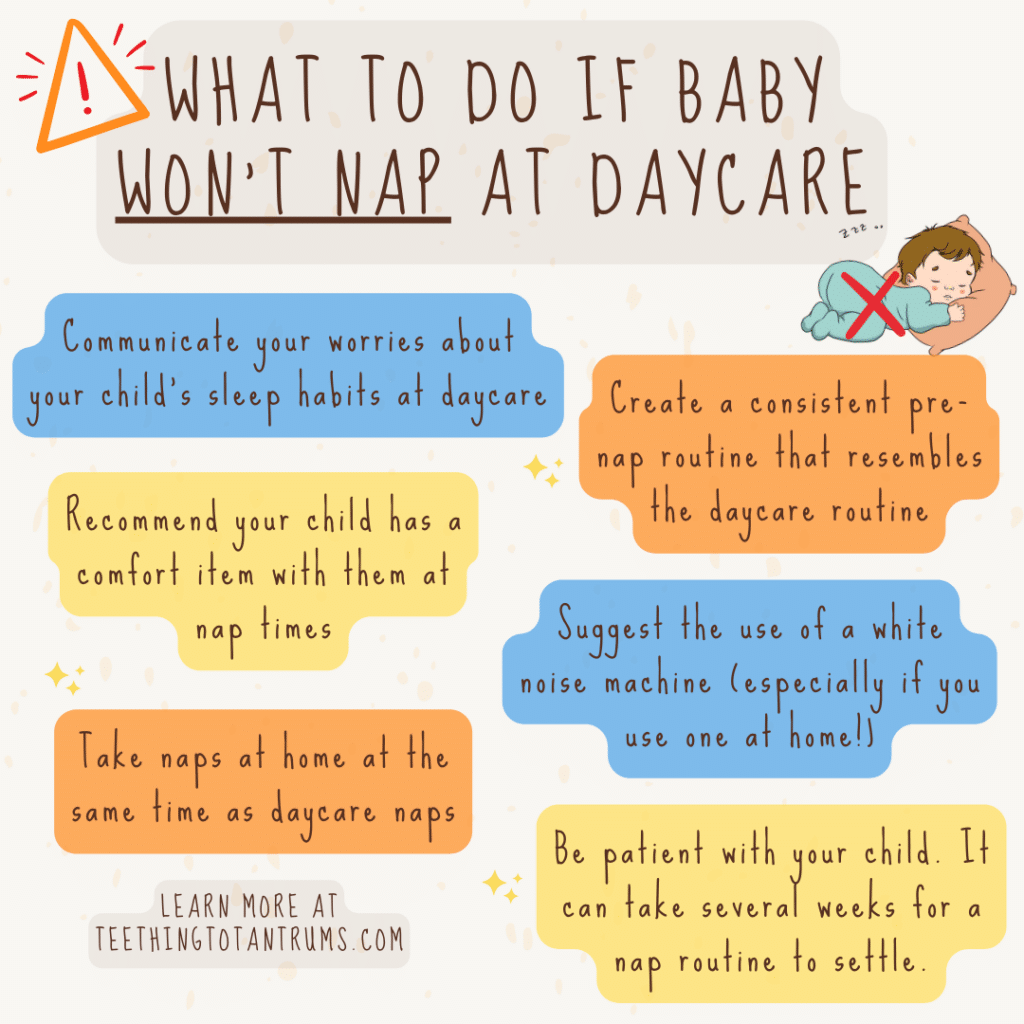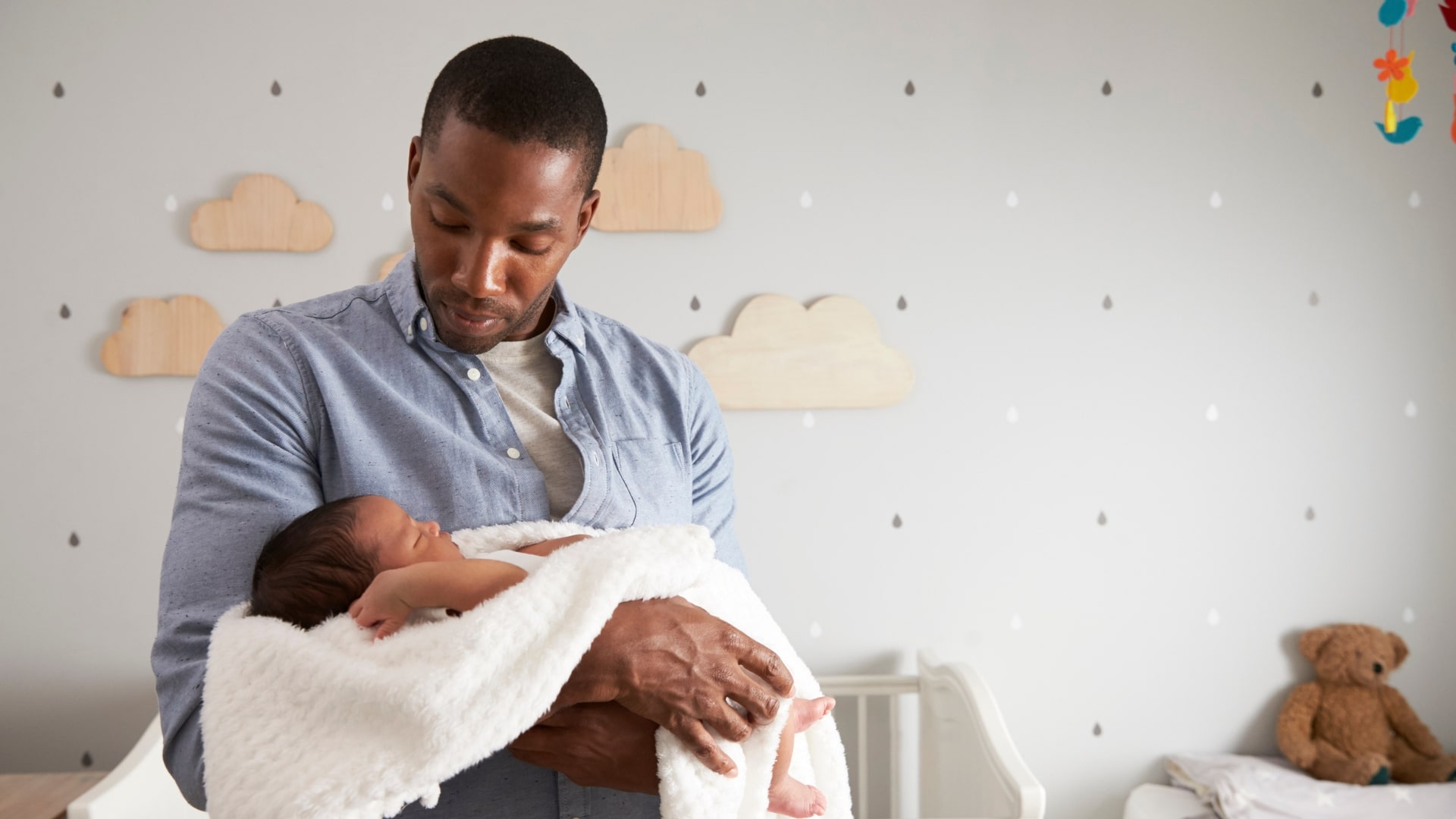I am always talking about how important a sleep schedule is for your little one’s development to ensure you all get the sleep you need and that naps should happen at the same time each day…
However, when your little one starts daycare you might be worried that your hard work creating this sleep schedule will fall away as napping at daycare throws the whole routine off…
But as daunting as it can be to hand your child over to daycare and wonder how things are going to change…
Young children are remarkably resilient!
So in today’s article, I will share with you what to expect from your child’s daycare to ensure their sleep stays on track and how to find the balance between napping at daycare and home.

Table of Contents
How Long Should Naps Be At Daycare
The ideal nap duration for most babies and toddlers ranges from 1.5 to 2 hours and there is no reason why this cannot continue at daycare. This nap length allows for sufficient rest without interfering with your child’s nighttime sleep.
Here’s a quick guideline for nap times by age:
- Infants (under 12 months): Several naps as needed, typically lasting from 30 minutes to 2 hours each.
- Toddlers (1–3 years): One nap per day, aiming for 1.5 to 2 hours.
- Preschoolers (3–4 years): May still require a nap, often shorter, around 1 hour.
It’s important to mention that when your little one starts daycare, the staff will likely ask for your child’s current nap schedule to see how they can adapt it to their routine as best as possible.
NOTE: Daycare centers are required to follow strict regulations concerning safe sleep for the children in their care which includes providing cribs with well-fitting firm mattresses and making regular checks on sleeping babies.
Are Daycare Naps Different From Naps Taken At Home?
When your child naps at daycare, the sleep will be slightly different from naps taken at home… However, this does not mean that you need to change your routine on days they are at home.
In daycare, the environment is more communal and extremely stimulating, which impacts how and when your child sleeps.
The good news is that your child is capable and adaptable, and they will quickly learn the daycare’s nap routine and how this routine is different from what they have established at home.
The length and number of naps can vary between daycare and home too. At daycare, there might be a set nap time that all children follow, while at home, you have the flexibility to adjust naps to your child’s needs.
It’s also common for daycare settings to adopt a one-nap routine for toddlers, even if your child has stopped napping during the day at home. This gives children the opportunity to nap if they are tired, but also to have quiet time to recharge their batteries.
Length of naps for babies:
- Home: You might find your baby takes longer naps at home, due to a quieter setting.
- Daycare: Naps may be shorter due to distractions and a busier environment.
Length of naps for toddlers:
- Home: Your toddler may not nap every day or may have dropped to no naps but has a quiet time instead
- Daycare: Your toddler may nap well after lunch due to being more tired after a stimulating morning.
Looking to get your little one to sleep quickly and effortlessly? Check out my Bedtime and Nap Cheat Sheet and master the art of making daytime naps and bedtimes as seamless as possible.
A bedtime & nap cheat sheet so good your little one will ask you to put them to bed...
Laura Williams "This is a life saver! I'm so glad I downloaded your bedtime & nap cheat sheet. My little one actually asked me to put him to bed last night! Unbelievable! Thank you so much!"
Click Here For The FREE Cheat Sheet
How To Prepare For Napping At Daycare
One of the best things you can do BEFORE your child starts daycare is to have an Adjustment Period as I will guarantee that both you and your child will need time to adjust to the new sleep schedule at daycare, which can take anything from a 1 to 3 weeks.
If it’s possible, ask your child’s daycare for a guideline for when naps are taken. Then gradually shift your child’s nap times by 10 minutes per day until your home naps match the daycare’s timings.
If you can make this change before your little one attends daycare, you will be giving them the best opportunity to maintain their routine and stay well-rested.
HOWEVER, if your child is due to start daycare soon or you do not have wiggle room to adjust the current home nap schedule, then the best way to help your little one through the nap change is to adjust bedtime to fit the daytime napping.
You may find that the new stimulation at daycare will likely mean that your child will be more tired than normal resulting in them falling asleep in the car on the way home…
If your little one has a nap in the car, ensure they have an age-appropriate wake window when they get home before bedtime. Learn more about the best wake window for your little one here.
Likewise, if your child does not nap on the way home then be prepared to bring bedtime forward.
Of course, having a recognizable bedtime routine is essential to keeping things on track at home, and ensuring you have a calming transition leading up to the bedtime routine once you get home is also key.
Keeping open communication with your daycare provider about any concerns you might be having can help you work together to create the best sleep schedule for your child’s needs too.
REMEMBER: As tempting as it might be to keep your child up to play (as you have not seen them all day) it can easily lead to them becoming overtired which will disrupt their ability to fall and stay asleep at night.

What To Expect From A Baby Napping At Daycare
When your infant starts daycare, nap times will differ from those at home.
Daycare environments, while safe and nurturing, often have predefined schedules that align with the sleep needs of multiple children.
This means that your baby will need to adapt to a new routine, which includes sleep.
At daycare, cribs and cots are commonly used for napping with your baby being assigned a specific crib or cot for consistency and to make them feel more secure and comfortable.
Remember, nap times vary among babies, depending on their age and individual sleep skills. Some infants may take multiple short naps, while others might nap longer. In the daycare setting… these schedules cannot all be adapted individually.
But this does have its benefits.
In daycare, your baby will learn to sleep in an environment with other infants. This helps them to enhance their sleep skills, such as self-soothing.
As a rule, babies initially have shorter naps (20-30 minutes) at daycare than at home due to the fact they are adapting to a noisier and more stimulating environment.
If you find your baby is very tired after daycare, you can bring bedtime forward or allow for a cat nap on the way home to help your baby find the right balance for their sleep needs.
Keep in mind that individual attention from caregivers can also support your baby’s sleep habits.
With time and patience, your infant will likely settle into a routine that includes sufficient rest during their daycare days.
TOP TIP: It is very common for young children to experience separation anxiety when they start daycare. Be patient and ensure you spend some quiet one-on-one time with your little one when they get home. Be prepared for some bedtime issues as they struggle with feeling insecure and be patient and supportive until they settle back to normal within a couple of weeks.
Will My Baby Nap At Daycare?
It’s normal for infants to require a period of adjustment before settling into a new nap routine at daycare. Initially, they might be distressed as they settle into their new environment and as a result, will struggle to nap. However, most youngsters settle in well and start to nap consistently at daycare within 2 weeks.
What Happens If My Child Doesn’t Nap At Daycare
It is important to be prepared for some disruption to your little one’s sleep quality, nap times, and behavior when they start daycare.
Many children, when they first start daycare, struggle to nap in their new environment especially if they are struggling with separation anxiety. This can easily lead to overtiredness and a change in their normal behavior.
You may notice them being more irritable or having a hard time focusing on tasks.
Daycare staff typically have strategies to help non-nappers rest or engage in quiet activities to help prevent overtiredness.
Quiet time can be spent reading, coloring, or playing with quiet toys. These activities help to ensure that non-nappers still get some downtime manage their energy levels and prevent overtiredness.
Watch out for signs of overtiredness when you get home such as hyperactivity, whining, being more clingy than normal, or having meltdowns, and adjust bedtime by making it earlier than normal to help rebalance your child’s sleep needs.
REMEMBER: It’s important to communicate with the daycare about your child’s sleep needs. Let the staff know if your little one is not sleeping well. They are experienced and can offer helpful strategies when napping at daycare and at home.
What Can I Do If My Baby Won’t Nap At Daycare
If your baby is struggling to nap at daycare there are things you can do to help your little one settle in.

- Communicate with daycare staff: Start by discussing with your baby’s daycare providers to see what you can do to establish a nap schedule that aligns with the daycare’s routine. I would always recommend using a daycare provider that has a separate sleeping room dedicated to infant nap times.
- Create a Consistent Pre-Nap Routine: Establishing a familiar nap ritual at home that translates easily to daycare can help. You might include a specific song or a quiet time story. Make sure that the daycare staff knows this routine so that they can help your baby settle more easily.
- Recommend a Comfort Item: A transition lovey or small blanket from home can provide some familiar comfort and security. Ensure that the item is allowed at your daycare and is safe for your child’s age.
- Suggest the Use of White Noise: White noise can be soothing and can block out the stimulating sounds of daycare. Ask if your daycare center can provide this or if you can bring a portable device.
- Have Daycare Nap Timings at Home: On weekends, practice taking baby’s naps at a similar time to that of their daycare routine.
- Be Patient: Keep in mind that adjustments take time. Your baby might take several days or even a couple of weeks to adapt to a new nap routine at daycare. Observing and tweaking the approach as needed is essential for daytime sleep success.
TOP TIP: Always keep your daycare staff aware of how your baby has slept at home. I.e. did they have a bad night, wake earlier than normal, or tough weekend? If they know what they are dealing with they are more likely to be able to adapt to your baby’s sleep requirements that day.
How To Adjust Bedtime To Fit With Daycare Naps
While in an ideal world, I would advocate putting your little one to bed at the same time every night when they start daycare you may have to be flexible for a while until they have settled in.
You may need to shift bedtime earlier if necessary, especially if naps at daycare have ended early, are shorter than usual, or have not gone well.
Bringing bedtime forward will help to rebalance your little one’s sleep needs.
However if your little one naps on the way home from daycare, you may need to move bedtime out to accommodate the nap and ensure your child is ready to sleep when put down for bed.
Also, keep an eye on sleep cues. If your little one is showing signs of being tired after a day at daycare then bringing bedtime forward is a must.
If you are not sure if your child needs to catch up on some sleep, calculate the total amount of sleep they need in a 24-hour period.
Infants need 12 to 16 hours of sleep a day, including naps. Toddlers should get 11 to 14 total hours, and preschool-aged children should get 10 to 13 total hours of sleep a day.
If your child’s sleep amount is significantly under, they will become overtired. If they have too much sleep, they will be under-tired. Either way, your bedtime and nap times will likely need to be adjusted to help your baby sleep properly.

Use Weekends Wisely
Weekends provide the ideal opportunity for your little one to catch up on any sleep they may have lost during the week at daycare or for you to help them adapt to the daycare nap schedule.
If your child is very tired, let them have a lie-in and take longer naps ensuring that you leave time for an age-appropriate wake window at the end of the day so they are ready for bedtime.
If they don’t need extra sleep, I would try to maintain a similar sleep schedule to that of daycare days for consistency.
Young children are more adaptable than we give them credit for and most will settle into a new routine after a settling-in period (about 2 weeks).
Frequently Asked Questions About Napping At Daycare
Navigating nap time at daycare can be challenging both for you and your little one. This section aims to address your common concerns and questions about napping at daycare.
Q: What if my baby follows a different sleep schedule at home?
A: Your baby’s home sleep schedule may not perfectly align with daycare so communication with your daycare provider is key. Discuss your child’s needs and routine clearly. Daycare staff are very experienced in adjusting schedules to ease the transition for your baby.
Q: Can napping at daycare trigger a sleep regression?
A: Sleep regressions can occur as a result of a change to your child’s environment. So, yes, starting daycare may trigger one. However, regressions are normally temporary and will settle once your child adapts to the new napping routine. Consistency at home and daycare can help mitigate potential sleep disruptions.
Q: Can I request a daycare create a certain sleep environment?
A: Yes, you can request the daycare to create a more conducive sleep environment for your child. Most daycares have policies in place to ensure a comfortable space, with individual cots, dim lights, and a quiet atmosphere during nap times. But you can always mention white noise machines and night lights if that is what helps your child sleep.
Q: Can napping at daycare ruin sleep training?
A: Napping at daycare shouldn’t ruin sleep training as long as similar principles are followed. Reinforce sleep routines and consult with the daycare about their approach to ensure consistency with your training methods.
Q: What strategies do daycares use to encourage napping among babies and toddlers?
A: Daycares employ various strategies to encourage napping. These include set nap times, creating a soothing environment, and following individual sleep cues. Dedicated cribs in a separate room for babies and comfort measures like special mats and quiet activities before nap time for toddlers also support the sleep process.
Q: What is a typical nap time policy at most daycares?
A: Most daycares establish a nap time policy that includes scheduled rest periods after lunch. They ensure a quiet and dark room to encourage sleep and have mattresses or cots for each child, often with individual blankets. For infants, they will normally have a dedicated sleep room with cribs where babies can take naps throughout the day.
Q: How do daycares handle sleep regression in young children?
A: Daycares address sleep regressions by maintaining consistent nap schedules and routines. They also work closely with parents to understand any changes and apply strategies to help the child return to a regular napping pattern.
Q: Can a toddler be expelled from daycare for not napping?
A: Expulsion from daycare for not napping is highly unlikely. Providers understand the variability in children’s sleep patterns. If your toddler is a non-napper they are likely to encourage a quiet time instead while others nap.
Need More Parenting Help?
- Download our FREE Bedtime & Nap Sleep Cheat Sheet. It’s a free, easy-to-use and proven formula designed for parents of 0-5 year olds to master the art of consistently undisturbed and restful sleep without the yelling, nagging or exhausting long-winded evenings.
- Check out our Parenting Toolbox. You’ll get access to expertly-chosen products that you can guarantee are the best for your little one and your wallet.
- Are you looking for personalized guidance to navigate the challenges of parenting? I offer 1-on-1 consultations to bring you tailored strategies and actionable advice to help support your child's growth and well-being with confidence.

A bedtime & nap cheat sheet so good your little one will ask you to put them to bed...
Laura Williams "This is a life saver! I'm so glad I downloaded your bedtime & nap cheat sheet. My little one actually asked me to put him to bed last night! Unbelievable! Thank you so much!"
Click Here For The FREE Cheat Sheet


